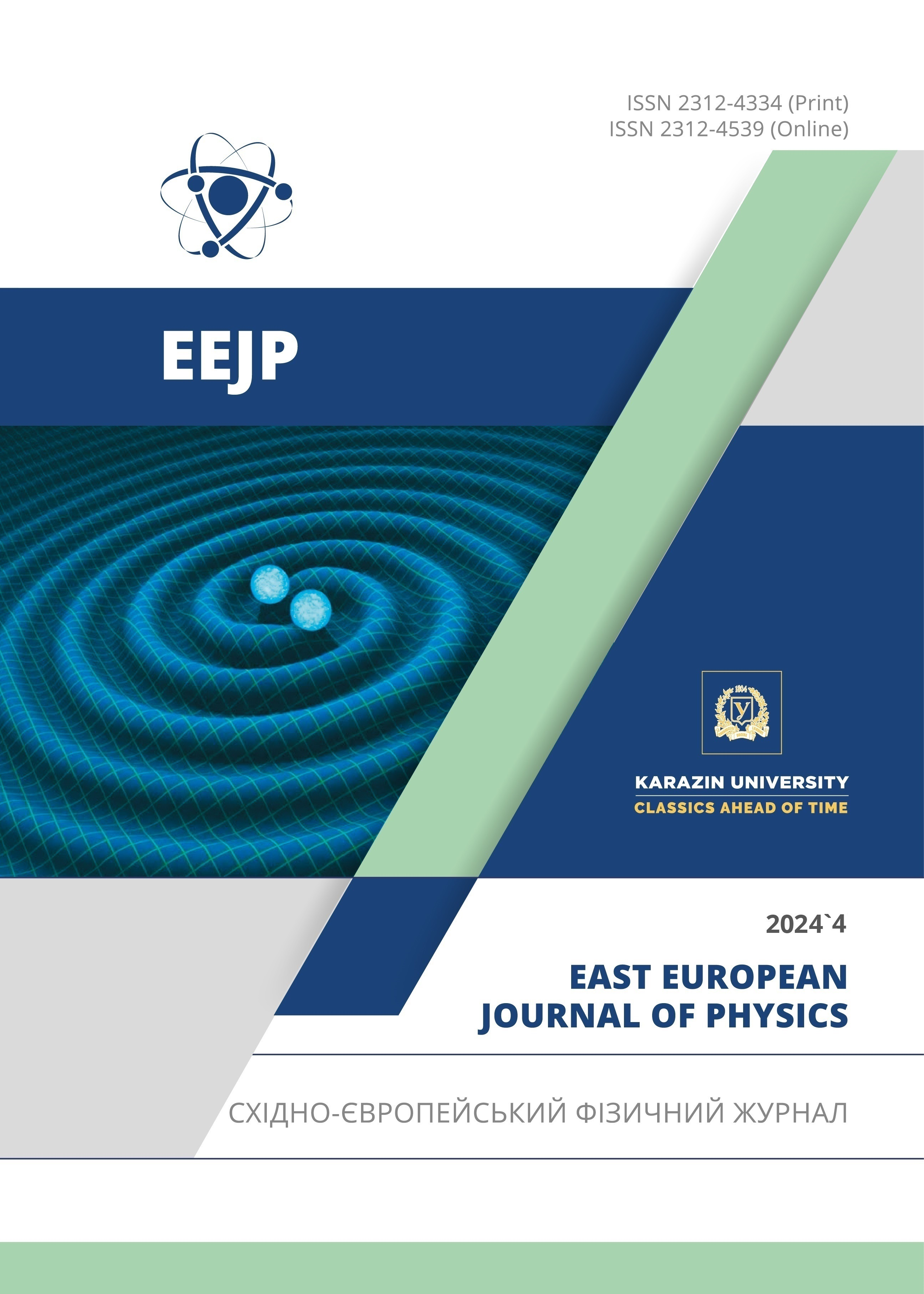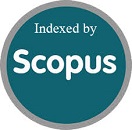Вплив температури спікання на мікроструктуру та властивості кераміки з оксиду цирконію для потреб ядерної енергетики
Анотація
У статті наведено експериментальні результати отримання високощільної кераміки на основі (ZrO2+3%Y2O3), яка є перспективною для використання як матриця зберігання високоактивних відходів. Досліджено вплив температури спікання в діапазоні 1100…1650 °С на мікроструктуру спечених таблеток. Фазовий склад і мікроструктуру дослідних зразків було охарактеризовано за допомогою рентгенівської дифрактометрії (РСА) та сканувальної електронної мікроскопії (SEM). Аналіз розподілу зерен за розмірами проводили з використанням аналізатора зображень "Thixomet". Мікротвердість зразків визначали з використанням металографічного комплексу LECO (США), інвертованого мікроскопа IM-3MET і стаціонарного твердоміра UIT HVB-30. Встановлено, що підвищення температури спікання призводить до суттєвого збільшення середнього розміру зерен (від 85 нм до 1000 нм) і підвищення щільності спечених таблеток. Для отримання щільної кераміки (щільність 97...98% від теор.) температури спікання становили 1550…1650 ºС, отримані значеннями мікротвердості склали > 12 ГПа та тріщиностійкості 5,5…6,3 MПа·м1/2.
Завантаження
Посилання
R. Heimann, T. Vandergraaf, “Cubic Zirconia as a Candidate Waste Form for Actinides Dispositions Studies,” J. Mater. Sci. Lett. 7, 583-586 (1988). https://doi.org/10.1007/BF01730301
S.S. Khin, Immobilization of actinide wastes in ceramics for long-term disposal, (Publikations server der RWTH Aachen University, 2006). http://publications.rwth-aachen.de/record/51927/files/Soe_Khin.pdf
S. Saienko, G. Kholomieiev, Zh. Azhazha, L. Ledovskaia, and A. Pilipenko, “Assessing Efficiency of Radioactive Waste Isolation in Containers of Different Materials,” Nuclear and Radiation Safety, 3, 36-42 (2015). https://doi.org/10.32918/nrs.2015.3(67).07 (in Russian)
S.Yu. Sayenko, M.M. Belash, E.S. Gevorkyan, T.E. Konstantinova, O.E. Surkov, V.A. Chishkala, I.A. Danylenko, and F.V. Belkin, “Production of nanoceramics based on zirconium dioxide by hot vacuum pressing,” Fizika I tehnika vysokih davleniy, 18(1), 47-52 (2008). (in Russian)
K. Maca, M. Trunec, P. Dobsak, and J. Svejcar, “Sintering of Bulk Zirconia Nanoceramics,” Rev. Adv. Sci. 5, 183-186 (2003). https://www.ipme.ru/e-journals/RAMS/no_3503/maca/maca.pdf
K. Maca, M. Trunec, and P. Dobsak, “Bulk Zirconia Nanoceramics Prepared by Cold Isostatic Pressing and Presureless Sintering,” Rev. Adv. Sci. 10, 84-88 (2005). https://www.ipme.ru/e-journals/RAMS/no_11005/maca.pdf
D. Sanchita, J.W. Drazin, W. Yongqiang, et al., “Radiation Tolerance of Nanocrystalline Ceramics: Insight from Yttria Stabi-lized Zirconia,” Scientific Reports, 5, 7746 (2015). https://doi.org/10.1038/srep07746
D. Sanchita, J. Mardinly, W. Yongqiang, et al., “Irradiation-induced grain growth and defect evolution in nonocrystalline zirconia with doped grain boundaries,” Phys. Chem, Chem. Phys. 18, 16921-16929 (2016). https://doi.org/10.1039/C6CP01763K
А.N. Velikodnyi, V.N. Voyevodin, M.A. Tiкhonovsky, V.V. Bryk, A.S. Kalchenko, S.V. Starostenko, I.V. Kolodiy, et al., “Structure and properties of austenitic ODS steel 08Cr18Ni10Ti,” PAST, 4, 94-102, (2014). https://vant.kipt.kharkov.ua/TABFRAME1.html
I.V. Kolodiy, O.M. Velikodnyi, M.A. Tikhonovsky, V.N. Voyevodin, O.S. Kalchenko, R.L. Vasilenko, and V.S. Okovit, “Microstructure and mechanical properties of oxide dispersion strengthened high-entropy alloys CoCrFeMnNi and CrFe2MnNi,” PASТ, 2(132), 87-94 (2021), https://doi.org/10.46813/2021-132-087
S. Ukai, and M. Fujiwara, “Perspective of ODS alloys application in nuclear environments,” J. Nucl. Mater. 307-311, 749-757 (2002). https://doi.org/10.1016/S0022-3115(02)01043-7
M. Lubszczyk, J. Wyrwa, K. Wojteczko, et al., “Electrical and Mechanical Properties of ZrO2-Y2O3-Al2O3 Composite Solid Electrolytes,” J. Electron. Mater. 50, 5933–5945 (2021). https://doi.org/10.1007/s11664-021-09125-x
R. Parveen, P. Kalita, R. Shukla, et al., “Investigation of radiation tolerance of yttria stabilized zirconia in the ballistic collision regime: Effect of grain size and environmental temperature,” 551, 165344 (2024). https://doi.org/10.1016/j.nimb.2024.165344
M.H. Ghaemi, S. Reichert, A. Krupa, M. Sawczak, A. Zykova, S. Sayenko, K. Lobach, and Y. Svitlychnyi, “Zirconia ceramics with additions of Alumina for advanced tribological and biomedical applications,” Ceramic International, 43(13), 9746–9752 (2017). https://doi.org/10.1016/j.ceramint.2017.04.150
A.V. Shevchenko, V.V. Lashneva, E.V. Dudnyk, A.K. Ruban, L.I. Podzorova, "Synthesis and physicochemical properties of ceramics from nanocrystalline zirconium dioxide powder,” Nanosystems, Nanomaterials, Nanotechnologies, 9(4), 881-893 (2011). https://www.imp.kiev.ua/nanosys/media/pdf/2011/4/nano_vol9_iss4_p0881p0893_2011.pdf (in Russian)
A.V. Shevchenko, V.V. Lashneva, E.V. Dudnyk, A.K. Ruban, V.P. Redko, V.V. Tsukrenko, D.G. Verbylo, N.N. Brychevsky, "Manufacturing technology and physicochemical properties of ceramics based on nanocrystalline powder of zirconium dioxide composite,” Nanosystems, Nanomaterials, Nanotechnologies, 12(2), 333-345 (2014). https://www.imp.kiev.ua/nanosys/media/pdf/2014/2/nano_vol12_iss2_p0333p0345_2014.pdf (in Russian)
W. Li, A. Armani, M.C. Leu, et al., “Properties of partially stabilized zirconia components fabricated by the ceramic on-demand extrusion process,” in: Proceedings of the 27th Annual International Solid Freeform Fabrication Symposium – An Additive Manufacturing Conference Reviewed Paper, (2016). https://www.researchgate.net/publication/313158956
S.Yu. Sayenko, “Isolation of radioactive waste using hot isostatic pressing,” Nuclear and Radiation Safety, 1(65), 41-48 (2015). https://doi.org/10.32918/nrs.2015.1(65).10
K.V. Lobach, S.Yu. Sayenko, E.O. Svitlichnyi, and O.E. Surkov, “Application of the electroconsolidation method for obtaining ceramics on the basis ZrO2-3%Y2O3,” PAST, 76(6), 99-102, (2011). https://vant.kipt.kharkov.ua/ARTICLE/VANT_2011_6/article_2011_6_99.pdf (in Russian)
E.O. Svitlychnyi, "Preparation of ZrO2-3%Y2O3 ceramics from nanoscale powder and study of its properties,” Zbirnyk naukovyh prats PAT “UkrNDIvognetryviv im. A.S. Berezhnogo,” 113, 53-57 (2013). http://nbuv.gov.ua/UJRN/vognetryv_2013_113_9 (in Russian)
ASTM E 112-96 Standard Test Method for Determination Average Grain Size.
K. Niihara, R. Morena, and D.P.H. Hasselman, “Evaluation of K1C of brittle solids by the indentation method with low crack-to-indent ratios,” J. Mater. Sci. Lett. 1, 13-16 (1982). https://doi.org/10.1007/BF00724706.
K. Harada, A. Shinya, D. Yokokama, and A. Shinya, “Effect of loading conditions on the fracture toughness of zirconia,” Journal of Prosthodomic Research, 57, 82-87 (2013). https://doi.org/10.1016/j.jpor.2013.01.005
M. Trurneс, “Effect of grain size on mechanical properties of 3Y-TZP ceramics,” Ceramics – Silicaty, 52(3), 165-171 (2008). https://www.ceramics-silikaty.cz/2008/pdf/2008_03_165.pdf
M. Yinbin, M. Kun, M. Laura, et al., Experimental studies of Micro- and Nano-grained UO2: Grain Growth Behavior, Surface Morphology, and Fracture Toughness ANL/NE-16/12/, (Nuclear Engineering Division, Argonne National Laboratory, 2016). https://publications.anl.gov/anlpubs/2016/10/130669.pdf
R. Ruh, K.S. Mazdiyasni, P.G. Valentine, and H.O. Bielstein, “Phase relations in the system ZrO2-Y2O3 at low Y2O3 contents,” J. Am. Ceram. Soc. 67, 190-192 (1984). https://doi.org/10.1111/j.1151-2916.1984.tb19618.x
G.A. Gogotsy, and A.V. Bashta, "Investigation of ceramics by Vickers diamond pyramid,” Problemy prochnosti, 9, 49-54 (1990). https://dspace.nuft.edu.ua/handle/123456789/9764 (in Russian)
D. Coric, R.M. Manic, L. Curkovic, and I. Zmak, “Indentation fracture toughness of Y-TZP dental ceramics,” in: 16th International Conference on New Trends in Fatigue and Fracture (NT2F16), (Dubrovnic, Croatia, 2016). https://core.ac.uk/download/pdf/79433762.pdf
A.G. Evans, and E.A. Charles, “Fracture Toughness Determination by Indentation,” J. Am. Ceram. 59, 371-372 (1976). https://doi.org/10.1111/j.1151-2916.1976.tb10991.x
J.-D. Lin, and J.-G. Duh, “Fracture toughness and hardness of ceria and yttria-doped tetragonal zirconia ceramics,” Mater. Chem. Phys. 78, 253–261 (2002). https://doi.org/10.1016/S0254-0584(02)00327-9
Авторське право (c) 2024 І.О. Чернов, К.В. Лобач, С.Ю. Саєнко, І.В. Колодій, С.В. Литовченко, О.В. Пилипенко, Г.О. Холомєєв, Б.О. Мазілін

Цю роботу ліцензовано за Міжнародня ліцензія Creative Commons Attribution 4.0.
Автори, які публікуються у цьому журналі, погоджуються з наступними умовами:
- Автори залишають за собою право на авторство своєї роботи та передають журналу право першої публікації цієї роботи на умовах ліцензії Creative Commons Attribution License, котра дозволяє іншим особам вільно розповсюджувати опубліковану роботу з обов'язковим посиланням на авторів оригінальної роботи та першу публікацію роботи у цьому журналі.
- Автори мають право укладати самостійні додаткові угоди щодо неексклюзивного розповсюдження роботи у тому вигляді, в якому вона була опублікована цим журналом (наприклад, розміщувати роботу в електронному сховищі установи або публікувати у складі монографії), за умови збереження посилання на першу публікацію роботи у цьому журналі.
- Політика журналу дозволяє і заохочує розміщення авторами в мережі Інтернет (наприклад, у сховищах установ або на особистих веб-сайтах) рукопису роботи, як до подання цього рукопису до редакції, так і під час його редакційного опрацювання, оскільки це сприяє виникненню продуктивної наукової дискусії та позитивно позначається на оперативності та динаміці цитування опублікованої роботи (див. The Effect of Open Access).








